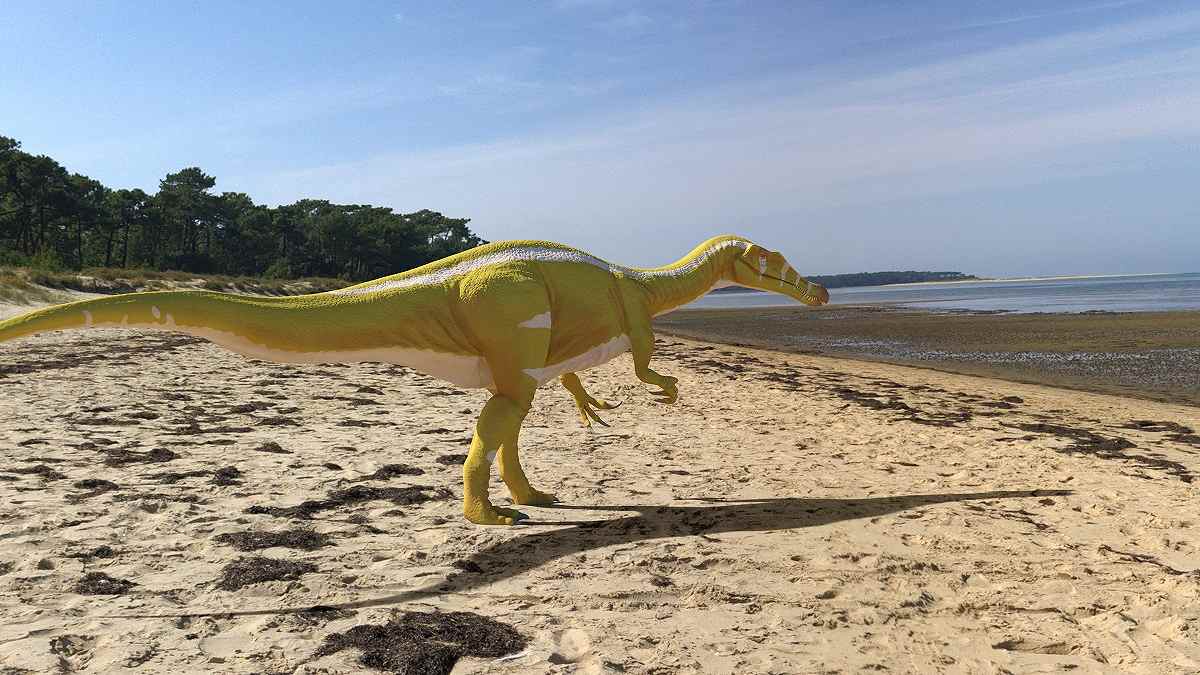
The Cretaceous Period meat-eating dinosaur Protathlitis cinctorrensis from Spain is seen in this illustration.
15:46 JST, June 8, 2023
WASHINGTON (Reuters) — During the Cretaceous Period in a lush coastal region in eastern Spain, an impressive dinosaur with an elongated and vaguely crocodile-like skull was on the prowl for a meal, its curved and serrated teeth able to rip the flesh of its prey.
Scientists said last month they had unearthed a partial skeleton of a previously unknown dinosaur species in the town of Cinctorres in the Spanish province of Castellon that helps provide a deeper understanding of a highly successful group of meat-eaters that hunted on land and in the water.
Living about 126 to 127 million years ago, the bipedal dinosaur, named Protathlitis cinctorrensis, was about 10 to 11 meters long and weighed about 2 tons. It was part of a group called spinosaurs whose biggest member, Spinosaurus, was among the largest meat-eating dinosaurs on record.
Spinosaurs in turn were part of a larger assemblage called theropods that included all of the meat-eating dinosaurs, including the likes of the massive Tyrannosaurus from North America and Giganotosaurus from South America, as well as birds.
The newly discovered dinosaur, whose scientific name means “champion from Cinctorres” in reference to the UEFA Europa League soccer title won by nearby Villarreal in 2021, is known from a partial skeleton — the right upper jawbone, one tooth, and five vertebrae.
Other dinosaurs excavated at Cinctorres include a large, long-necked quadrupedal plant-eater, two smaller bipedal plant-eaters and another theropod that was not as big as Protathlitis. Fossils of various crocodiles, sharks and other fish also have been dug up.
Protathlitis was closely related to a spinosaur called Baryonyx unearthed in England in the 1980s that lived at roughly the same time. Both had skulls more elongated that many other meat-eating dinosaurs. Baryonyx also had a very large claw on the first finger, though no limb remains of Protathlitis were found.
Protathlitis roamed a coastal region along the Tethys Sea, an ocean whose remnants include the Mediterranean Sea.
Some spinosaurs — in particular Spinosaurus — are thought to have lived a semi-aquatic lifestyle, hunting primarily fish. Protathlitis did things differently.
“Protathlitis probably hunted on land near coastal zones and only occasionally hunted fish,” said paleontologist Andres Santos-Cubedo of Universitat Jaume I in Spain, lead author of the research in the journal Scientific Reports.
Spinosaurs lived in Europe, Africa, Asia and South America during the Cretaceous — the last of the three chapters of the age of dinosaurs. But because their fossils are relatively scarce, scientists are still trying to figure out their early history and how they spread around the world.
The new discovery bolsters the notion that during the early Cretaceous, two lineages of spinosaurs — those closely related to Baryonyx and those closely related to Spinosaurus — occupied the western part of Europe, then migrated to Africa and Asia, where they would diversify, said geologist and study coauthor Sergio Meseguer of Universitat Jaume I.
In Europe, the Baryonyx relatives were dominant, while the Spinosaurus relatives were most abundant in Africa.
Spinosaurus, about 15 meters long and weighing 7 tons, lived 95 million years ago in Africa. Its anatomy was unlike any other dinosaur, with a relatively small pelvis, short hind legs, paddle-like tail and feet for propulsion in the water and a curious sail-like structure of bony spines 2 meters tall on its back.
Unlike Protathlitis, Spinosaurus possessed unserrated teeth — better to capture slippery aquatic prey.
"Science & Nature" POPULAR ARTICLE
-

Genome Study Reveals Milestone in History of Cat Domestication
-

Big Leap in Quest to Get to Bottom of Climate Ice Mystery
-

Security Camera Footage Vulnerable to Outside Access; Investigation Finds 3,000 Pieces Exposed Online
-

Paws on Parade: Nairobi’s Dogs Dazzle at ‘Pawchella’
-

Japan Set to Participate in EU’s R&D Framework, Aims to Boost Cooperation in Tech, Energy
JN ACCESS RANKING
-

Keidanren Chairman Yoshinobu Tsutsui Visits Kashiwazaki-Kariwa Nuclear Power Plant; Inspects New Emergency Safety System
-

Imports of Rare Earths from China Facing Delays, May Be Caused by Deterioration of Japan-China Relations
-

University of Tokyo Professor Discusses Japanese Economic Security in Interview Ahead of Forum
-

Japan Pulls out of Vietnam Nuclear Project, Complicating Hanoi’s Power Plans
-

Govt Aims to Expand NISA Program Lineup, Abolish Age Restriction





















